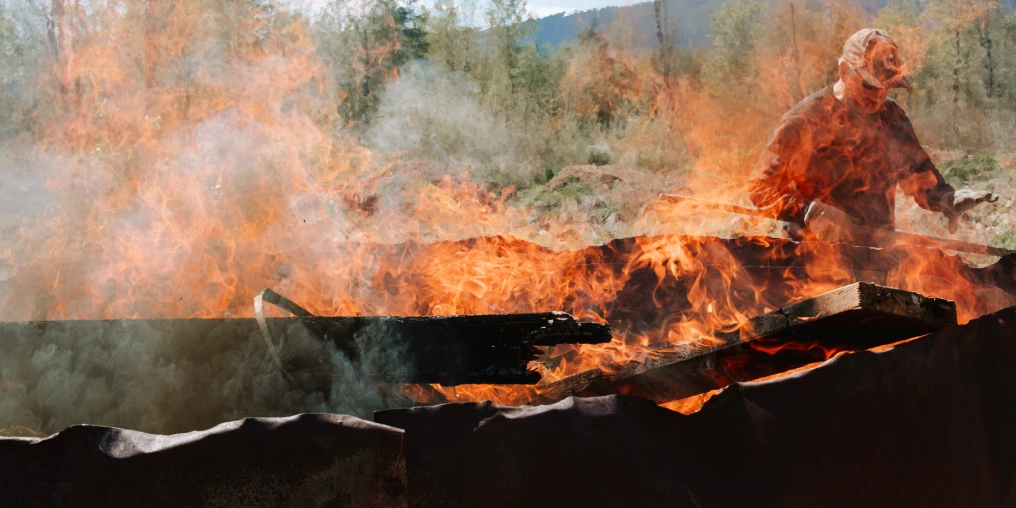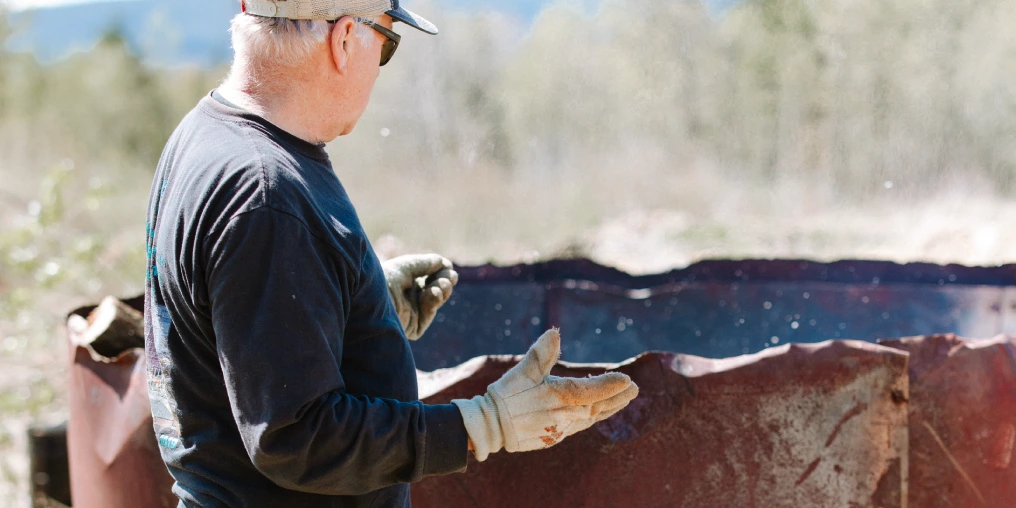Biochar is a super charcoal made by heating any biomass—such as old woody debris—without oxygen. All of the cellulose, lignin, and other non-carbon materials gasify and burn away.
What remains is pure carbon—40 to 50 per cent of the carbon originally contained in the biomass. Essentially, it is the charcoal left in your fire ring after you put out the campfire.

What is biochar and how does it work as a climate solution?
Possibly the greatest overarching threat facing our world is the climate crisis. All that carbon we’ve been releasing since the start of the Industrial Revolution has produced a greenhouse effect responsible for the rapid and catastrophic shift in world weather patterns.
As it turns out, biochar is one of the greatest tools we have to combat this—by sequestering carbon and storing it in the ground, instead of releasing it into the atmosphere.
The Intergovernmental Panel on Climate Change (IPCC) has stated that biochar “is an important carbon removal technology with several co-benefits.”
How biochar enables carbon sequestering for centuries
Trees are absolute masters at taking carbon out of the atmosphere and locking it into their cellular structure as a building block.
However, when we burn a tree—or a derivative such as fossil fuel—we release carbon back into the atmosphere. On a certain level, this is a natural process kept in balance by our forests, oceans, and grasslands absorbing the carbon again.

Unfortunately, we have tipped the balance by excessive burning—and our natural systems cannot absorb all this carbon dioxide.
However, if we convert the biomass into biochar through a process called pyrolysis, then the carbon is locked into a crystalline state, where it remains for many hundreds, if not thousands, of years.
The subtle—yet oh-so-important—difference here is the removal of oxygen from the process. Fire is built on three basic ingredients: fuel, heat, and oxygen. Remove the oxygen, and we no longer have combustion. Instead, we have pyrolysis. And that is how we sequester carbon into a solid state.
“Biochar is one of the greatest tools we have to combat climate change—by sequestering carbon and storing it in the ground, instead of releasing it into the atmosphere.”
Making biochar from backyard projects to industrial scale
My journey with biochar began after I read an essay in Drawdown, a book that that proposes a comprehensive plan for reversing global warming. I was intrigued. Since then, I have read a few more books, watched hundreds of YouTube videos, and I eventually began experimenting with making it myself.
I had been very worried about the trajectory our civilization is on—with apparent disregard for the natural world and the security of our grandchildren’s future. With a problem as big as this, I wondered how I could make any difference at all and what, exactly, I could do. It soon became clear that there is something I can do to mitigate my own personal carbon footprint: make lots of biochar.

People all over the world are making biochar on every scale imaginable—from the backyard hobbyist, like myself, to large, industrial-scale projects.
An example of this: Google is purchasing carbon credits totalling 100,000 tons from Varaha, an Indian biochar startup. This project will set up six industrial biochar reactors in India, each with the capacity to lock 30 tons of CO₂ per day.
Their biomass is an invasive species of mesquite that has aggressively advanced into productive farmland. Typically, the mesquite is gathered and left in piles to burn or rot; now it will be converted into biochar, sequestering the carbon for thousands of years.
Google is purchasing another 100,000 tons from Charm Industrial, an American firm.
So, I imagine you’re wondering: what’s my deal with biochar? Well, I make it.
“To me, making biochar is a win-win-win: it improves our soil, reduces wildfire risk, and helps fight climate change—all from unwanted woody debris.”
Creating biochar using a flame cap kiln
I began by purchasing a flame cap kiln—a very well-designed, simple tool for dealing with large amounts of brush. I use this to help property owners reduce the combustible woody biomass on their properties; it’s quite effective at creating the conditions needed for pyrolysis to occur.

A flame cap kiln effectively concentrates the fire on the top of the heated biomass, thereby starving the lower pile of oxygen while maintaining a high temperature.
The flame burns the gases, not the wood. A counterflow of air is established, which keeps the flames low and sucks most of the smoke produced back into the flames, where it is burned.
Some smoke is released into the atmosphere, but it’s far cleaner than a normal slash burn.
I load up the kiln with woody debris (brush or wooden construction offcuts) and begin a fire inside. As the fire burns down, I add successive layers of biomass. Each time, the fire stays concentrated on top of the pile.
At the end of the day, I let it burn down to glowing embers, then quench it with water—and voilà! A biochar bonanza.

To me, making biochar is a win-win-win. By turning unwanted woody debris into useful material, we help improve the health of our soil, forests, and bioflora—and mitigate against the risk of wildfire and climate change. It’s a simple and smart way to help our planet.
Biochar soil benefits: improving water, nutrients, and structure
The benefits include:
- Biochar is extremely porous, which allows it to absorb and hold water very effectively. When applied to soil, whether it be in your back garden, a farm field, or the forest floor, it acts as a buffer against drought conditions.
- Biochar’s porosity provides a home for soil microorganisms, much like a coral reef in the ocean. When the smallest creatures have a home to grow and flourish, it benefits all life forms in the food web (including humans, of course).
- Biochar is nearly pure carbon, which is a fundamental building block of life. The addition of carbon to soil enhances its fertility.
- Biochar improves soil fertility by retaining plant nutrients and reducing nutrient runoff.
When ground to a uniform particle size, biochar greatly improves the tilth (health) of the soil, as well as its structure and aeration.
This list scratches the surface of biochar’s potential. It can also be used in many non-agricultural applications: as a construction aggregate, asphalt additive, acoustic insulation, and in the production of wood vinegar (a natural pest control and fertilizer) and carbon fibre, to name a few.





